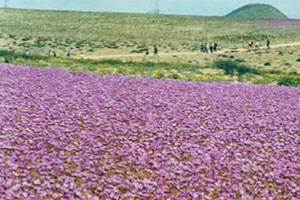The northern zone of our country contains, for a considerable extension, the most arid and dry desert in the world. We are referring to the Atacama Desert, whose boundaries go from the border with Peru to approximately the Elqui river (region of Coquimbo), and from the slopes of the western range of the Andes to our country’s coastal area. It is located, latitude-wise, near the Tropic of Capricorn, just like the desert in Namibia in Africa and the Australian deserts.
This place’s conditions are so extreme that the average rainfall can easily reach 0,1 millimeters a year. Its temperatures during the day are quite high, going up to 45ºC, while at night they drop abruptly, even under 10ºC.
It is common for it to rain once every fifteen years, but this does not happen in every area, reason for which scientists state that there are zones in which a single drop of rain has never fallen.
It is more of a rocky desert, in which sand is scarce and there are few places where important dunes have formed. Thicker particles dominate the landscape, like gravel and cobbles.
There are several phenomena that enable and explain the extreme conditions of the Atacama Desert. The main one is the action of high and low pressure centers, which act upon the precipitation that could take place at the Chilean northern coast, diminishing its presence in this sector. In addition, the Andes mountain range also act as a real “insulating barrier” that prevents the passage of storms charged with humidity coming from the eastern zone of the American continent, mainly the Amazonian basin.
Inhabitants of the desert
The Atacama Desert presents different climate and biological conditions depending on the point we are located in. While there is a greater humidity at the coast due to morning mists or camanchacas, when one moves inland conditions change, the same happens if we ascend towards the altiplanic zone.
Next, we will analyze the inhabitants of the so-called “absolute desert”, ecological region located as an extended sash from the border with Peru to approximately the area near Copiapo (region of Atacama) and between the pre-altiplanic desert steppe and the coastal desert. This zone presents the most extreme conditions of the Chilean desert, with a scarce hydro contribution, great solar radiation, and in some areas, extreme soil salinity.
Overcoming all of these obstacles, organisms appear that take full advantage of the resources. Arborous species like the Tamarugo (Prosopis tamarugo) and the Chilean Mesquite (Prosopis chilensis) are characterized for its great resistance to dehydration and salinity, while herbs like Grama Salada (Distichlis spicata) and bushes like Cachiyuyo (Atriplex deserticola) and breas are also adapted and sporadically populate the most arid sector of the Atacama Desert.
Regarding the existing fauna, this zone has a low variety of species, among which certain reptiles are included, like the Paulina Lizard (Liolaemus paulinae), some birds like the Tamarugo Conebill (Conirostrum tamarugense) and the Diuca-finch (Diuca Diuca), amphibians like the Bufo atacamensis and the Sapito de Cuatro Ojos (Pleurodema thaul), and among the mammals there is a subterranean rodent called Tawny Tuco-Tuco (Ctenomys fulvus).
Color and aridity: the florid desert
One of the most attractive phenomena that occurs in the final portion of the Atacama Desert is the florid desert. Its appearance is directly conditioned by the presence of precipitation in the northern sector of our country, particularly in the region of Atacama, where the abundance of life can begin to be seen in the month of August, which is timidly born as a green cloak and shows multiple colors as early as September.
Two or ten years can go by, it is not an exact period, but once the water falls on the land, the arid surface “awakens” and generates the necessary conditions for a great amount of seeds brought by the wind to develop and flower. Species that where under the stupor of high temperatures and drought for years enjoy a few drops of rain that make their growth possible.
Flowers like country sighs, añañucas, huillis and lion claws and some irises make up a real carpet of flowers, which beats the adversity of the desert for a few days. Over 200 species, most of which are endemic, flower under natural conditions during this particular phenomenon. Not only plant species develop thanks to the unusual precipitation of this sector, the flowering also attracts a great amount of insects and birds, which make the landscape of the north of Chile a rich and unique natural ecosystem.








 Muere Evita
Muere Evita